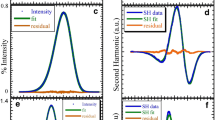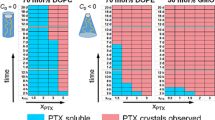Abstract
To understand the bilayer interaction with paclitaxel, fluorescence polarization, Fourier transform infrared spectroscopy (FT-IR) and 31-phosphorus nuclear magnetic resonance (31P-NMR) studies were performed on paclitaxel bearing liposomes. Fluorescence anisotropy of three probes namely, 1,6-diphenyl-1,3,5-hexatriene (DPH), 12-(9-anthroyloxy) stearic acid (12AS) and 8-anilino-1-naphthalene sulfonate (ANS) were monitored as a function of paclitaxel concentration in the unsaturated bilayers. The incorporation of paclitaxel decreased anisotropy of 12AS and ANS probes, while slightly increased anisotropy of DPH. Paclitaxel has a fluidizing effect in the upper region of the bilayer whereas the hydrophobic core is slightly rigidized. FT-IR spectroscopy showed an increase in the asymmetric and symmetric methylene stretching frequencies, splitting of methylene scissoring band and broadening of carbonyl stretching mode. These studies collectively ascertained that paclitaxel mainly occupies the cooperativity region and interact with the interfacial region of unsaturated bilayers and induces fluidity in the headgroup region of bilayer. At higher loadings (>3 mol%), paclitaxel might gradually tend to accumulate at the interface and eventually partition out of bilayer as a result of solute exclusion phenomenon, resulting in crystallization; seed non-bilayer phases, as revealed by 31P-NMR, thereby destabilizing liposomal formulations. In general, any membrane component which has a rigidization effect will decrease, while that with a fluidizing effect will increase, with a bearing on headgroup interactions, partitioning of paclitaxel into bilayers and stability of the liposomes.





Similar content being viewed by others
Abbreviations
- 12AS:
-
12-(9-Anthroyloxy) stearic acid
- ANS:
-
8-Anilino-1-naphthalene sulfonate
- DPH:
-
1,6-Diphenyl-1,3,5-hexatriene
- FT-IR:
-
Fourier transform infrared spectroscopy
- 31P-NMR:
-
31-Phosphorus nuclear magnetic resonance
- PC:
-
Phosphatidylcholine
- PG:
-
Phosphatidylglycerol
References
Panchagnula R (1998) Pharmaceutical aspects of paclitaxel. Int J Pharm 172:1–15
Dhanikula AB, Panchagnula R (1999) Localized paclitaxel (Taxol) delivery. Int J Pharm 183:85–100
Dhanikula AB, Panchagnula R (2005) Preparation and characterization of water-soluble prodrug, liposomes and micelles of paclitaxel. Curr Drug Deliv 2:75–91
Dhanikula AB, Singh DR, Panchagnula R (2005) In vivo pharmacokinetic and tissue distribution studies in mice of alternative formulations for local and systemic delivery of paclitaxel: gel, film, prodrug liposomes and micelle. Curr Drug Deliv 2:35–44
Straubinger RM, Balasubramanian SV (2005) Preparation and characterization of taxane-containing liposomes. Methods Enzymol 391:97–117
Zhang JA, Anyarambhatla G, Ma L, Ugwu S, Xuan T, Sardone T, Ahmad I (2005) Development and characterization of a novel Cremophor EL free liposome-based paclitaxel (LEP-ETU) formulation. Eur J Pharm Biopharm 59:177–187
Campbell RB, Balasubramanian SV, Straubinger RM (2001) Influence of cationic lipids on the stability and membrane properties of paclitaxel-containing liposomes. J Pharm Sci 90:1091–1105
Belsito S, Bartucci R, Sportelli L (2005) Paclitaxel interaction with phospholipid bilayers: high-sensitivity differential scanning calorimetric study. Thermochim Acta 427:175–180
Zhao L, Feng SS (2004) Effects of lipid chain length on molecular interactions between paclitaxel and phospholipid within model biomembranes. J Coll Interface Sci 274:55–68
Ali S, Minchey S, Janoff A, Mayhew EAA (2000) Differential scanning calorimetry study of phosphocholines mixed with paclitaxel and its bromoacylated taxanes. Biophys J 78:246–256
Bangham AD (1978) Properties and uses of lipid vesicles: an overview. Ann N Y Acad Sci 308:2–7
Zhou X, Arthur G (1992) Improved procedures for the determination of lipid phosphorus by malachite green. J Lipid Res 33:1233–1236
Hope ML, Redelmeier TE, Wong KF, Rodrigueza W, Cullis PR (1989) Phospholipid asymmetry in large unilamellar vesicles induced by transmembrane pH gradients. Biochemistry 28:4181–4186
Frohlich M, Brecht V, Peschka-Suss R (2001) Parameters influencing the determination of liposome lamellarity by 31P-NMR. Chem Phys Lipids 109:103–112
Lentz BR (1993) Use of fluorescent probes to monitor molecular order and motions within liposome bilayers. Chem Phys Lipids 64:99–116
Thulborn KR, Tilley LM, Sawyer WH, Treloar FE (1979) The use of n-(9-anthroyloxy) fatty acids to determine fluidity and polarity gradients in phospholipid bilayers. Biochim Biophys Acta 558:166–178
Engelke M, Jessel R, Wiechmann A, Diehl HA (1997) Effect of inhalation anaesthetics on the phase behaviour, permeability and order of phosphatidylcholine bilayers. Biophys Chem 67:127–138
Lotta TI, Salonen SI, Virtanen JA, Eklund KK, Kinnunen PK (1988) Fourier transform infrared study of fully hydrated dimyristoylphosphatidylglycerol. Effects of Na+ on the sn-1′ and sn-3′ headgroup stereoisomers. Biochemistry 27:8158–8169
Hubner W, Blume A (1998) Interactions at the lipid–water interface. Chem Phys Lipids 96:99–123
Garidel P, Blume A, Hubner WA (2000) Fourier transform infrared spectroscopic study of the interaction of alkaline earth cations with the negatively charged phospholipid 1,2-dimyristoyl-sn-glycero-3-phosphoglycerol. Biochim Biophys Acta 1466:245–259
Traikia M, Warschawski DE, Recouvreur M, Cartaud J, Devaux PF (2000) Formation of unilamellar vesicles by repetitive freeze–thaw cycles: characterization by electron microscopy and 31P-nuclear magnetic resonance. Eur Biophys J 29:184–195
Tyteca D, Schanck A, Dufrene YF, Deleu M, Courtoy PJ, Tulkens PM, Mingeot MP (2003) The macrolide antibiotic azithromycin interacts with lipids and affects membrane organization and fluidity: studies on Langmuir–Blodgett monolayers, liposomes and J774 macrophages. J Membr Biol 192:203–215
Crosasso P, Ceruti P, Brusa M, Arpicco S, Dosio F, Cattel L (2000) Preparation, characterization and properties of sterically stabilized paclitaxel-containing liposomes. J Control Release 63:19–30
Yun I, Cho ES, Jang HO, Kim UK, Choi CH, Chung IK, Kim IS, Wood WG (2002) Amphiphilic effects of local anesthetics on rotational mobility in neuronal and model membranes. Biochim Biophys Acta 1564:123–132
Casal HL, Mantsch HI (1984) Polymorphic phase behaviour of phospholipid membranes studied by infrared spectroscopy. Biochim Biophys Acta 779:381–401
Umemura J, Cameron DG, Mantsch HH (1980) A Fourier transform infrared spectroscopic study of the molecular interaction of cholesterol with 1,2-dipalmitoyl-sn-glycero-3-phosphocholine. Biochim Biophys Acta 602:32–44
Blume A, Hubner W, Messner G (1988) Fourier transform infrared spectroscopy of 13C=O-labeled phospholipids hydrogen bonding to carbonyl groups. Biochemistry 27:8239–8249
Hubner W, Mantsch HI (1991) Orientation of specifically 13C=O labeled phosphatidylcholine multilayers from polarized attenuated total reflection FT-IR spectroscopy. Biophys J 59:1261–1272
Balasubramanian SA, Straubinger RM (1994) Taxol–lipid interactions: taxol-dependent effects on the physical properties of model membranes. Biochemistry 33:8941–8947
Severcan F, Sahin I, Kazanci N (2005) Melatonin strongly interacts with zwitterionic model membranes-evidence of from FTIT and DSC. Biochim Biophys Acta 1668:215–222
Papova AV, Hincha DK (2003) Intermolecular interactions in dry and rehydrated pure and mixed bilayers of phosphatidylcholine and digalactosyl disacylglycerol: a Fourier transform infrared spectroscopy study. Biophys J 85:1682–1690
Lewis RNAH, McElhaney RN (1998) The structure and organisation of phospholipid bilayers as revealed by infrared spectroscopy. Chem Phys Lipids 96:9–21
Prenner EJ, Kiricsi M, Jelokhani-Niaraki M, Lewis RN, Hodges RS, McElhaney RN (2005) Structure–activity relationships of diastereomeric lysine ring size analogs of the antimicrobial peptide gramicidin S: mechanism of action and discrimination between bacterial and animal cell membranes. J Biol Chem 280:2002–2011
Boulanger Y, Schreier S, Smith IC (1981) Molecular details of anesthetic–lipid interaction as seen by deuterium and phosphorus-31 nuclear magnetic resonance. Biochemistry 20:6824–6830
Gjerde AU, Holmsen H, Nerdal W (2004) Chlorpromazine interaction with phosphatidylserines: a 13C and 31P solid-state NMR study. Biochim Biophys Acta 1682:28–37
Gao Z, Lukyanov AN, Chakilam AR, Torchillin VP (2003) PEG-PE/phosphatidylcholine mixed immunomicelles specifically deliver encapsulated taxol to tumor cells of different origin and promote their efficient killing. J Drug Target 11:87–92
Deo N, Somasundaran T, Somasundaran P (2004) Solution properties of amitriptyline and its partitioning into lipid bilayers. Colloids Surf B Biointerfaces 34:155–159
Yokouchi Y, Tsunoda T, Imura T, Yamauchi H, Yokoyama S, Sakai H, Abe M (2001) Effect of adsorption of bovine serum albumin on liposomal membrane characteristics. Colloids Surf B Biointerfaces 20:95–103
Schanck A, Deleers M (1993) 31P NMR study of the parameters influencing the formation of non-bilayer phases in model membranes. Biochem Biophys Res Commun 195:654–658
Bernsdorff C, Reszka R, Winter R (1999) Interaction of the anticancer agent Taxol (paclitaxel) with phospholipid bilayers. J Biomed Mater Res 46:141–149
Author information
Authors and Affiliations
Corresponding author
About this article
Cite this article
Dhanikula, A.B., Panchagnula, R. Fluorescence Anisotropy, FT-IR Spectroscopy and 31-P NMR Studies on the Interaction of Paclitaxel with Lipid Bilayers. Lipids 43, 569–579 (2008). https://doi.org/10.1007/s11745-008-3178-1
Received:
Accepted:
Published:
Issue Date:
DOI: https://doi.org/10.1007/s11745-008-3178-1




